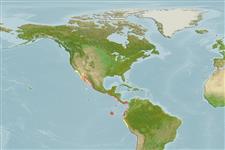>
Carangaria/misc (Various families in series Carangaria) >
Polynemidae (Threadfins)
Etymology: Polydactylus: Greek, poly = a lot of + greek, daktylos = finger (Ref. 45335).
More on authors: Lay & Bennett.
Environment: milieu / climate zone / depth range / distribution range
ນິເວດວິທະຍາ
ສັດທະເລ; ນ້ຳກ່ອຍ ອາໄສຢູ່ໃກ້ໜ້າດິນໃຕ້ພື້ນທ້ອງນ້ຳ; ລະດັບຄວາມເລິກ 10 - 60 m (Ref. 91172). Subtropical; 37°N - 12°S, 122°W - 77°W (Ref. 57343)
Eastern Pacific: Monterey Bay, California, USA to Callao, Peru. One record from the Galapagos Islands. Rare north of Baja California, Mexico (Ref. 2850). Record from Chile (Ref. 9068) needs to be verified (Ref. 57343).
ຂະໜາດ / ນ້ຳໜັກ / Age
Maturity: Lm ? range ? - ? cm
Max length : 36.8 cm TL ຕົວຜູ້/ບໍ່ມີເພດ; (Ref. 115882); common length : 20.0 cm TL ຕົວຜູ້/ບໍ່ມີເພດ; (Ref. 55763)
ຄີ (ໜາມ)ແຂງຢູ່ຫຼັງປາ (ທັງໝົດ): 9; ຄີຫຼັງຂອງປາ (ຄີອ່ອນ) (ທັງໝົດ): 11-13; ຄີ(ໜາມ) ແຂງຢູ່ຄີກົ້ນປາ
ກຸ່ມປາກະດູກແຂງ
ຄວາມຖີ່ຂອງກຸ່ມຖ່າຍທອດພັນ
ປາທີ່ມີການເຄື່ອນຍ້າຍຈາກທະເລໄປຫານ້ຳຈືດ ແລະນ້ຳຈືດຫາທະເລ
ປາທີ່ມີການເຄື່ອນຍ້າຍຈາກທະເລແລະໄປໄຂ່ຢູ່ນ້ຳຈືດ
ຄີກົ້ນຂອງປາ
ສັດທີ່ມີກະດູກສັນຫັຼງ
ການຖ່າຍທອດທາງກຳມະພັນຈາກພໍ່ແມ່ຫາລູກ 3; ຄີກົ້ນຂອງປາ: 13 - 15; ສັດທີ່ມີກະດູກສັນຫຼັງ: 24. Body grayish, no stripes or spots. Lip on lower jaw well developed. Dentary teeth restricted to dorsal surface. Maxilla not covered with scales. Pectoral filaments 6; longest not reaching beyond level of posterior end of anal fin base. Lateral line bifurcated on caudal fin membranes, extending to posterior margins of upper and lower caudal fin lobes. Swim bladder present (Ref. 45049).
Found in shallow water near the coast, on sand and mud bottoms (Ref. 9332). Larvae and small juveniles (>4 cm) are pelagic and sometimes occur several hundred kilometers offshore, whereas the larger juveniles and adults prefer shallow near-shore waters like bays, sloughs or estuaries where the bottom is sandy or muddy (Ref. 28023). Omnivorous, feeds on worms, sand crabs, shrimp, clams; sometimes feeds on fish like small anchovy (Ref. 28023). Esteemed food fish where it occurs (Ref. 57343). Also Ref. 55763.
Life cycle and mating behavior
ການຈະເລີນເຕັມໄວ | ການສືບພັນ | ການວາງໄຂ່ | ໄຂ່ | ຄວາມດົກຂອງໄຂ່ປາ | ຕົວອ່ອນ
Motomura, H., 2004. Threadfins of the world (Family Polynemidae). An annotated and illustrated catalogue of polynemid species known to date. FAO Spec. Cat. Fish. Purp. Rome: FAO. 3:117 p. (Ref. 57343)
IUCN Red List Status (Ref. 130435)
Threat to humans
Harmless
Human uses
ການປະມົງ: ເປັນສີນຄ້າ
ຂໍ້ມູນຕື່ມອີກ
ຊື່ສາມັນຄຳສັບຄ້າຍຄືກັນການເຜົາໃໝ້ພະລັງງານໂດຍປ່ຽນທາດອາຫານໃນຮ່າງກາຍໃຫ້ກາຍເປັນຊີ້ນແລະໜັງຜູ້ລ້າການສຶກສາຜົນກະທົບຂອງສານຜິດທີ່ມີຜົນກະທົບຕໍ່ລະບົບນິເວດການສືບພັນການຈະເລີນເຕັມໄວການວາງໄຂ່ການສັງລວມການວາງໄຂ່ຄວາມດົກຂອງໄຂ່ປາໄຂ່Egg development
ເອກະສານອ້າງອີງການລ້ຽງສັດນ້ຳຂໍ້ມູນການລ້ຽງສັດນ້ຳສາຍພັນກຳມະພັນElectrophoresesການຖ່າຍທອດທາງກຳມະພັນຈາກພໍ່ແມ່ຫາລູກພະຍາດການປຸງແຕ່ງNutrientsMass conversion
ຜູ້ຮ່ວມມືຮູບStamps, Coins Misc.ສຽງຫອຍມີພິດຊະນິດນຶ່ງທີ່ອາໄສໃນທະເລຄວາມໄວປະເພດການລອຍເນື້ອທີ່ເຫືອກOtolithsສະໝອງວິໄສທັດ
ເຄື່ອງມື
Special reports
Download XML
ແຫຼ່ງອີນເຕີເນັດ
Estimates based on models
Preferred temperature (Ref.
123201): 20.5 - 29, mean 25.9 °C (based on 273 cells).
Phylogenetic diversity index (Ref.
82804): PD
50 = 0.5000 [Uniqueness, from 0.5 = low to 2.0 = high].
Bayesian length-weight: a=0.00646 (0.00433 - 0.00962), b=3.06 (2.94 - 3.18), in cm total length, based on LWR estimates for this species & Genus-body shape (Ref.
93245).
ຊັ້ນເຂດຮ້ອນ (Ref.
69278): 3.6 ±0.6 se; based on diet studies.
ຄວາມຢືດຢຸ່ນ (Ref.
120179): ສູງ, ປະຊາກອນຕຳ່ສຸດທີ່ໃຊ້ເວລາສອງໜ້ອຍກວ່າ 15 ເດືອນ (Preliminary K or Fecundity.).
Fishing Vulnerability (Ref.
59153): Low to moderate vulnerability (27 of 100).
Nutrients (Ref.
124155): Calcium = 101 [51, 203] mg/100g; Iron = 1.13 [0.58, 2.10] mg/100g; Protein = 20.2 [18.6, 21.8] %; Omega3 = 0.402 [0.275, 0.617] g/100g; Selenium = 24.2 [12.8, 48.0] μg/100g; VitaminA = 9.48 [3.93, 22.61] μg/100g; Zinc = 0.904 [0.619, 1.327] mg/100g (wet weight);
